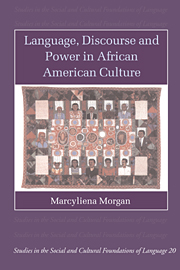Book contents
- Frontmatter
- Contents
- List of maps, figures and tables
- Acknowledgments
- Notes on the transcriptions
- Introduction
- 1 The African American speech community: culture, language ideology and social face
- 2 Forms of speech: verbal styles, discourse and interaction
- 3 Language norms and practices
- 4 When women speak: how and why we enter
- 5 Urban youth language: black by popular demand
- 6 Language, discourse and power: outing schools
- Notes
- References
- Index
- Studies in the Social and Cultural Foundations of Language
Introduction
Published online by Cambridge University Press: 17 November 2009
- Frontmatter
- Contents
- List of maps, figures and tables
- Acknowledgments
- Notes on the transcriptions
- Introduction
- 1 The African American speech community: culture, language ideology and social face
- 2 Forms of speech: verbal styles, discourse and interaction
- 3 Language norms and practices
- 4 When women speak: how and why we enter
- 5 Urban youth language: black by popular demand
- 6 Language, discourse and power: outing schools
- Notes
- References
- Index
- Studies in the Social and Cultural Foundations of Language
Summary
The study of African American language is the study of how people of African descent use language as a cultural resource that in turn represents, constructs and mediates social reality. I learned this truth as I was growing up on Chicago's segregated South Side in the late 1950s. When people in my childhood neighborhood talked about language and communication, as they frequently did, they referred to racial, social and regional differences and the importance of style and ambiguity in conversing with those in positions of power, especially under white supremacy. They also expressed great love and respect for conversations that were deeply ambiguous. Everyday conversations were always filtered through proverbs, references to past events and people. The past was never a concept about time but about perspective, the type of perspective that meant that even young children were told the truth about life in America – “All you have to do is stay black and die.”
There were always people “passing through” our home. My family included my grandfather, father, mother, aunts, uncles and five sisters. Together we lived on the top two floors of a three-story apartment building – with our apartments separated by sixteen stairs in the front and fourteen in the back. To us kids this separation meant little, as we proved daily when we jumped (or flew), in one fell swoop, from our place at the top of the back steps to the rest of my family at the bottom.
- Type
- Chapter
- Information
- Publisher: Cambridge University PressPrint publication year: 2002
- 1
- Cited by

